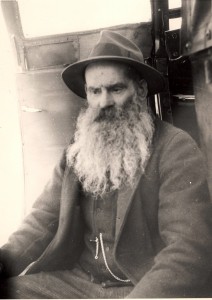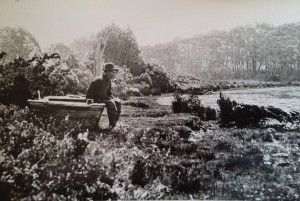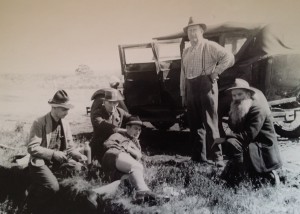
They said he was in hiding, a man on the run. Some said he was Dan Kelly, escaped from fiery Irish martyrdom at the Glenrowan Inn. Even a co-worker thought he was a mainland blow-in. He wasn’t. He was just Dave Courtney, Middlesex Plains stockman whose formidable facial hair foxed some people into thinking he had something to hide. Now, however, digitisation of state records makes Dave’s past an open book.
Dave Courtney is likely to have been born in Launceston as the fifth child of Buckinghamshire-born ex-convict Henry Courtney and Limerick-born free immigrant Johanna Mack on 5 September 1873. His childhood was probably miserable. Young Courtney received some formal education, since by his mid-teens he could read and write. By that time, however, his father was dead and he was embarking on a series of brushes with the law. Poverty was probably the cause of Courtney being apprehended for petty theft in Launceston as a twelve-year-old and again at fifteen. On neither occasion was a conviction recorded, but the latter event prompted his incarceration at the Cascades Training School, a reformatory established in the old Cascades Female Factory near Hobart, for four years. A brief escape from this institution five months later was short lived. He was then 16 years old, standing 5 feet and 3 inches tall. In 1891 he was working for a blacksmith in Margaret Street, Launceston. Any training he may have received at the Cascades or from the blacksmith was not evident in 1903, when David Courtney, labourer, of Bothwell, supposedly 32 years old, and now three inches taller, was sentenced to one month in gaol for larceny. It was his first actual conviction. As if in a throwback to the convict days, the police record is so detailed as to reveal that he bore several tattoos, two tree branches tattooed inside his right forearm, the initials ‘TC’ and other marks inside his left forearm, and a bracelet tattooed on his left wrist. A man of mystery—and yet, now, through the pleasures and perils of digitisation, a man of intimate details.
At some point Courtney got a job working with horses. In 1908 he was a horse trainer in Hobart, in 1913 a stud groom. Yet between these appointments he got into trouble again, spending another month in gaol under the Vagrancy Act after supposedly stolen brass couplings and brass bath plugs were found in his possession.
‘TC’ could have been Courtney’s brother Thomas. In January 1918, when 45-year-old David Courtney, of 341 Elizabeth Street, Hobart, disappeared after announcing he was travelling to the Huon district, it was Thomas who reported the matter to the police. However, Thomas Courtney’s description of his brother’s tattoos made it ‘TH’ and ‘AH’ on his left forearm!
(Let’s check the mystery man’s home on Google Earth—have the street numbers changed? If not, today it’s an old house converted into a sweet shop, smack bang in the middle of the North Hobart shopping precinct, only a few doors from the famous Renown Café.)
Two months later, Dave Courtney was located in Deloraine—and soon after that he was Frank Brown’s permanent replacement at Middlesex. Another former Middlesex stockman for Fields, Ben Brown, recalled the ‘mystery man’ who was a newcomer to Fields’ employ: ‘He had no relations in Tasmania, as far as I know. They reckoned he come off the boat in the first place. That’s how he came here, I reckon. He could have done’. If Dave was on the run, his brother blew his cover.
Remote stockmen were paid a meagre wage of perhaps £30 or £40 per year. Yet Courtney settled in at Middlesex Station, minding the stock, maintaining fences, patch-burning the plains and snaring marsupials for a crust. His nearest neighbour was Gustav Weindorfer of Waldheim Chalet, Cradle Valley, a naturalised Australian then in retreat from the anti-German hatred of World War I (1914–18). Hunters like Graham Riley also made Courtney’s acquaintance. ‘Eskimos and polar bears!’, Riley recalled him exclaiming one winter, but the frost and snow did not beat him. Courtney built a picket fence around his vegetable garden to flummox possums and ravens, and so successful was he that one year he exhibited his carrots and turnips in downtown Sheffield. Big money was made in the fur trade during the 1920s. When, in 1926, £200-worth of Courtney’s skins, saddles and other possessions were destroyed in a hut fire, he posted a £100 reward for conviction of the arsonist. Yet, contrarily, at another time Dave sold the snaring rights to Middlesex for a bottle of rum. He liked ‘a little drop of thick stuff’.
Courtney could also stop a wild bull. Hunter Harold Cook applied his technique one day on Sunshine Plain near the Vale of Belvoir:
“A big red fella [bull] came out and started pawing the ground and twisting his tail round, and I had Ian and Dale Smith from Erriba with me, and they said, ‘Let’s run’. And I said, ‘No, stand still’, and I set me two dogs down. We stood there and watched him for a few minutes, and he turned around and walked off. They said, ‘How did you now that?’ ‘Well’, I said, ‘Dave Courtney told me that’.”

Photos survive which appear to show Courtney rescuing early Cradle Mountain visitors like Fred Smithies and HJ King, driving a bullock team which hauled their vehicles out of the Middlesex mud. Smithies snapped him in the days of his moustaches, before he grew that brush possum-like beard. It was said that his moustaches could have been tied behind his back, making his murder by suffocation possible.
Courtney left Middlesex for a time in 1931, when he was replaced by Ted Farrell. He took a job in the far north-west. In 1935 he claimed £90 worker’s compensation from Rickman F Furmage of Deloraine after an injury sustained while slashing gorse at Woolnorth resulted in the amputation of a forefinger. Now out of work, Courtney lost the case. By 1938, now 65 years old, he was back at Middlesex. As of old, he would meet visitors at the station gate, where a billy full of tea would be brewing. John Riley recalled Courtney and four others bringing in 158 head of cattle from Middlesex back to Deloraine, spending the first night at Erriba, the next probably at Sheffield, in 1938 or 1939.

Middlesex was sold after JT Field’s death in 1940, and for a time Courtney was a stockrider at the White Rock, Mersey River, near Railton. Dave Courtney, ‘late of Middlesex’, died at the Devon Hospital, Latrobe, in 1945. His age was given as 84, but he appears to have been 71 years old. If ever the truly evocative story of the Field family graziers goes to press, ‘Jack the Shepherd’ Francis, his wives Maria, Mary Ann, and son George; the various Browns (Jacky, Linda, Frank, Louisa and Ben); and Dave Courtney will all feature in the tale of Middlesex, their home on the range.
Great story! Your brilliant writing style is such a pleasure to read. More please.
Thanks, Sue, you’re always too kind to me.
In typical chilly September weather I had a quick visit to Lake Lea last Sunday and can just imagine Courtney with his wild beard out there on the plains. Your stories give a great human side to a landscape which at first glance seem so devoid of human activity.
If ever the Field story goes to press……… go for it Nic
Thanks, Bill, Lake Lea is a great place to be when the white and pink stylidium bloom or when the straggly waratah blossom as they compete for the sun in the little forest on the northern edge of the lake. When are you coming back? Actually there is a great Smithies shot of a sullen, moustached Courtney on horseback, but I’ve just moved house and of course I can’t find it!
Bring on the Field Brothers story ! Nic this article brought Dave to life, not just a series of records from various sources. Thank you and well done.
Thanks, Val
Great story, Nic. I love the idea that Courtney was a mystery to his acquaintance in his later life, but that the records tell at least some of his real story. Very nicely written.
As a kid my father and his drothers talked a lot about Dave Courtney. The family lived outside Wilmot at the base of what was called Gail’s hill. The small 3 room cabin was up off the road on the right side of the road. The property is now covered with plantation trees. My uncle said that when he was a young boy he used to cut Dave Courtney’s hair. He always said that he was afraid someone would cut off his beard. It seems Dave used to call in to the house and have a meal and in doing so would bring meat for the family. Cheers, Alan Jeffrey.
Hi Alan, thanks for writing, it’s sad, isn’t it, the way that the old houses and buildings around Erriba have disappeared under plantation? Anyway, interesting to hear about your uncle cutting Dave’s hair. Did he say anything about Dave?
Sorry for not replying earlier. I remember my uncle saying that he liked my uncle cutting his hair because he was not tempted to cut it off. My father and uncle always said he seemed to be hiding away from something. Maybe it was just rumours that had spread around the area about him. It was quite an isolated location at that time. My father left school at an early age and went and worked in the bush and in the mines in the Bell area. I have a letter from EG Higgs making my father the above ground forman at his Narrawah creek mine whilst he was away on holidays. We have old photos of my father and others well up huge trees on shoes cutting trees with axes. I find the history of the area fascinating. I would like to personally thank you for the time you have devoted in your research of the area. Cheers, Alan.
Hi Alan, great to hear from you again. I agree that it’s a fascinating area, and I feel like I am just starting to learn about it. It’s really good to hear from other people interested in the history. Did your father work for sawmills as a faller? The Higgs mine must have been an eye opener, with the improvised technology. We might never find out why Dave Courtney ended up in the north of the state after going missing in Hobart. He certainly seems to have left in a hurry and on the quiet.
Hey Nic, thanks for the chatter. Like you I love the history or the Cradle area. I just wish I had made notes when I was a kid sitting listening to the old stories of the old days when my dad was a kid. It was a tough time back then. My dad was the eldest in the family of 9. He was born in 1903. I am not sure when his father moved onto the property that was opposit Masons road corner. I have so much to find out. Have called into the Wilmot museum but it seems the Jeffrey family are the least documented but one of the first settlers in the area. Just my luck. I have been to the old Higgs mine on a few occasions and it was just fantastic to see what went on there. I had old photos taken by my dad and it was hard to make sence of it all. Anyway thanks again Nic. As a side note my daughter brought me a copy of your book The Wild Ride for my birthday a couple of weeks ago and I think it will be a fantastic read as all your stuff is. Keep up the good work mate. Cheers Alan.
Sorry for the long delay, Alan, and thanks for the comments, I hope you enjoy The wild ride. Many people, including me, have those regrets about not writing down the stories we were told when we were young, or not asking enough questions. Did your grandfather open the property opposite Masons Road corner? If so, it should show up in the land titles.
Hey Nic, I think my grandfather opened the property in question. I have no idea how to find out more. I have not completed an research into my grandfather other than what I was told my my father. I think it’s time to dig a bit deeper.
Hi Alan, Land Titles and a play on Ancestry.com on line might help you.Nic